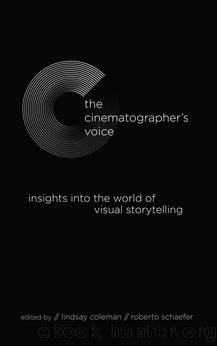The Cinematographer's Voice by Lindsay Coleman;Roberto Schaefer;

Author:Lindsay Coleman;Roberto Schaefer; [Schaefer;, Lindsay Coleman;Roberto]
Language: eng
Format: epub
ISBN: 9781438486413
Publisher: SUNY Press
Published: 2022-09-15T00:00:00+00:00
Notes
1. A window is actually a visual window placed over any area on the image to do controlled adjustment to that area alone, or to everything around it without affecting the image in the window. On modern post systems, there are an infinite number of windows available to use.
2. Arri raw is an image capture system available on modern Arriflex digital cameras, considered the highest quality due to its expanded latitude and widely adjustable final image. The ISO or ASA sensitivity of the camera when shooting is only a metadata reference and can be changed to anywhere in the available range of the camera when finishing the images. Most other camera manufacturers have their version of raw, a name taken from digital still cameras. They are not uncompressed, but much less so than most other systems like ProRes, Rec. 709, and so on, which have the sensitivity âbaked inâ to the digital files.
3. This might be read as misleading because shooting on film is not what gives the cinematographer more control. It keeps others in postproduction from greatly altering the captured image if the work is done photochemically in the traditional film sense, and not in a digital intermediate where the film negative is converted to digital files. At that point in the DI, there is almost as much control to alter the imagery as there is in material originated digitally, especially in so-called raw. If the film is transferred to a digital file, you have as much control in the DI suite as you do on an Alexa raw file, unless the negative is highly over- or underexposed.
4. The Macbeth chart was developed for the print industry and worked well with photochemical timing but not so well with digital because the colors are in a different color space than the RGB or P3 of video and therefore reproduce differently. I believe that Mathieson is actually combining two different chart references here. There is the 18 percent gray card, which is the value used by light meters for judging exposure. If you expose a grey card correctly at the value where the lens T-stop is set then the way you want the scene to look should fall in place. If you put a color over the lens or light when you expose the gray card, the timer will then adjust to remove that color, bringing the gray back to neutral, which will effectively color the scene opposite of the color you used. For example, if you put blue on the card the timer will remove the blue, effectively adding red-orange to the scene. In reality there are charts for digital gray and color reference that use colors that exist in the digital video realm. DSC makes one of the best, and the old standby Kodak gray card is still applicable.
Download
This site does not store any files on its server. We only index and link to content provided by other sites. Please contact the content providers to delete copyright contents if any and email us, we'll remove relevant links or contents immediately.
How To Write A Damn Good Thriller by James N. Frey(375)
Naked as Nature Intended by Pamela Green(363)
30 Movies to Get You Through the Holidays by Roger Ebert(360)
Bond, James Bond by Brad Gilmore(293)
It's Only a Movie! by Haberski Jr. Raymond J(277)
Chinese films in focus II by Unknown(255)
The Fellowship of the Knits: Lord of the Rings: The Unofficial Knitting Book by Tanis Gray(241)
How To Write A Novel The Easy Way Using The Pulp Fiction Method To Write Better Novels: Writing Skills by Jim Driver(234)
The Greatest Show on Earth by Jerry Pinto(222)
Smartphone Cinema: Making Great Films with Your Mobile Phone by Bart Weiss(211)
Film Truth; November, 1920 by Anonymous(211)
The Garden in the Machine by Unknown(206)
The Reel Truth by Reed Martin(198)
Charles McGraw by Alan K. Rode(197)
Jurassic Park and Philosophy by Watkins Jessica Michaud Nicolas(196)
Jafar Panahi: Interviews by Unknown(193)
Euro-Visions: Europe in Contemporary Cinema by Mariana Liz(191)
Thomas Mann and Friedrich Nietzsche: Eroticism, Death, Music, and Laughter by Caroline Joan Picart(190)
The Japanese Cinema Book by Hideaki Fujiki & Alastair Phillips(187)
